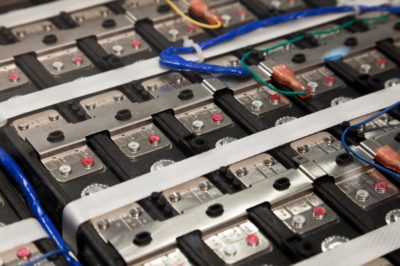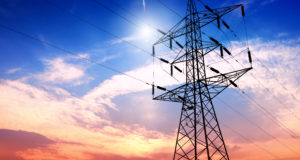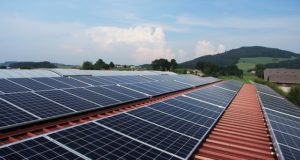Has anyone ever written an ode to batteries? If so, we can be pretty sure the aspiring poet who did so was an alternative energy enthusiast who discovered firsthand how absolutely essential it is to have a well-supplied battery bank available to store all the energy that solar panels or windmills are capable of collecting. When a battery bank has been properly sized, selected, and situated, a renewable energy system’s full productive potential can finally be unleashed, and any off-the-gridder who is serious about energy independence will need to become educated about all the important aspects of effective battery logistics.
In part one, we took a close look at the choices available for consumers interested in purchasing batteries for use with off-the-grid energy systems. Here, we will explore the total battery bank concept a bit more in-depth, detailing just a few of the factors and requirements that off-the-gridders must consider when setting up, operating, and maintaining their very own renewable energy mini-storage facility.
Calculations And Specifications
Battery banks connected to renewable energy systems must have the power and the capacity to meet the needs of electricity-hungry homesteading families. Of course, every step should be taken to conserve energy wherever possible, but let’s face it – as Americans, we have come to expect electrical power to be available on demand. Few of us, no matter how dedicated we might be to staying off the grid, are going to be satisfied sitting around in the dark for half the day simply because our solar panels, windmills, or micro-hydro systems aren’t being fully utilized, because we lack the required battery capacity to store and deliver all the energy they are able to harvest.
So how do you determine just how big your battery bank should be, assuming you want it to supply you generously for 365 days a year? The best way to make precise calculations is to take a look at your monthly utility bills over the course of a year to see just how much electricity, in the form of kilowatt-hours (kWh), your family has been using. Naturally you will want a battery bank that can meet your needs when they are at their peak, which would be in either the heart of winter or summer, depending on your location. So after you have calculated your maximum potential daily energy needs, you will need to figure out how much capacity your bank should have in order to meet those needs over a 48-to-120 hour period (2 to 5 days). This extra capacity is necessary because when the sun stops shining or the wind stops blowing, there is no guarantee things will be back to normal the following day. You will also need to keep in mind that deep-cycle batteries are never discharged completely, because doing so would shorten their lifespan considerably. Ideally, you should plan a 30 to 50 percent discharge for your battery bank for each period of longest continuous use.
So let’s work our way through an example. Suppose you determined that your maximum daily energy use was about 1,000 watt-hours per day – the equivalent of one kWh – and that you wanted a battery bank that could provide power for your home for three days continuously at a discharge level of 50 percent. One kWh for three days would equal three kWh in total, but a 50 percent discharge means you would need to double this number, so in this situation you would want a battery bank with the capacity to supply six kWh of power before it would need to be recharged.
Translating this to battery selection, your battery’s strength of charge (measured in volts) and its storage capacity (measured in amp-hours) can be converted to watt-hours for the purposes of comparison through a simple equation: Ah x V = W (amp hours multiplied by volts equals watt-hours). So if the cumulative voltage of your battery bank were set at 48V, to reach 6 kWh (6,000 watt-hours) you would need to have a total available storage capacity/discharge potential of 125 amp-hours running.
So after this initial calculation has been completed, the next question is, how do you actually assemble, piece by piece, a battery bank that will be able to supply the necessary kWh of energy? Fortunately, this is relatively easy: the first step is to arrange a set of batteries in series to hit the required voltage, and then you must connect this in parallel to another series (or two more series) in order to reach the required amp-hour capacity. Batteries can be assembled in series by using cables to connect the negative terminal of one battery to the positive terminal of its neighbor, in linear sequence, with input from the renewable energy system on one end and output from the inverter on the other.
Harness the power of the sun for your energy needs…
When batteries are connected in series their voltages will combine, so a string of eight 6V batteries linked together will actually function like one big 48V battery. Parallel connections are made by using secondary cables to link a negative terminal from one battery in one series to a positive terminal from another battery in an adjacent series, which will instantly double (or triple if three series are connected) amp-hour capacity. The general idea is to meet as much of your kWh requirements as you can by connecting batteries in series first, and then adding parallel links to boost capacity as necessary. Any more than three series in a battery bank is not recommended, however, because efficiency is lost if a bank gets too big.
Picking A Location
Location is everything in real estate, and it is pretty important for battery banks, too. Like baby chicks or flowers, they need to be kept in climate-controlled conditions, ideally where temperatures can be maintained in the 70-to-75⁰F range all year round. This requirement may seem a bit impractical if you live in an area that experiences temperature extremes, either in summer or winter, but as the expression goes, “it is what it is” – batteries are rated for this temperature level, and when they are kept in warmer conditions, it will shorten their lifespan and force you to replace them much too quickly. Colder temperatures do not reduce battery lifespan, which is good, but the colder a battery is, the more it will need to be charged in order to reach full capacity, and extra charging means you will be wasting resources, and this should always be anathema to off-the-grid pioneers.
Some temperature variation may be inevitable, but you should try to make sure indoor temperatures in your battery storage area don’t rise above 80⁰F or dip below 50⁰F. Insulated storage sheds with passive solar heating, retractable shading options for summer, and good internal thermal mass capacities to moderate the interior climate between AM and PM can reduce the need for artificial heating or cooling, but if you decide to make use of the sun by including windows, you must make sure the sun never shines directly on the batteries, since this can send their internal temperatures soaring. Good ventilation is important in the summer to help keep things cool, but it is also necessary at all times because as battery banks charge, the chemical reactions involved will emit small but potentially explosive quantities of hydrogen and oxygen gasses. This is not something you have to be overly concerned about; you just need to make sure that the airflow in your energy storage area is consistent and reliable enough to prevent a buildup of these dangerous gasses.
Maintenance
Flooded lead-acid batteries contain an acidic solution that acts as an electrolyte, facilitating the flow of electrical charge. However, the water in that solution will evaporate over time, and it therefore must be checked at least every three months and replenished as needed.
When checking electrolyte levels or adding water to a battery, you will be working in close proximity to a caustic liquid substance, so it will be necessary to take some precautions. Safety goggles and acid-resistant gloves should be worn, and when you are peering inside the battery to check fluid levels, you should use a plastic or non-metallic flashlight and make sure to turn it on and off only when you are away from the battery. These considerations should not be taken lightly – over 2,300 people are seriously burned in the Unites States each year while tinkering with lead-acid batteries, and unless you want to join their company, you had best be very careful about how you handle your batteries. When you need to add some water to your electrolyte solution, it is best to use a self-leveling filler that will replenish the battery’s water supply to a predetermined level (overfilling must be avoided, or you could end up with a bubbling, toxic mess once your battery begins to discharge). Mineral-free distilled water should be used when refilling a flooded lead-acid battery, and you should only fill them when they are fully charged.
Cleanliness is not just a trivial consideration with battery banks. Any leakage, exterior corrosion, or accumulated gunk can interfere with proper terminal/cable connections and possibly even ruin a battery completely. In a sense, your battery bank is almost like a set of teeth, and those “teeth” need to be brushed regularly to make sure they remain clean and sparkling and free from decay. And just as baking soda makes a perfect natural toothpaste, so too will a baking soda solution, consisting of at least two tablespoons of soda mixed with a pint of water, keep batteries free of dirt, grime, and accumulations of acid reflux. Baking soda has natural acid neutralizing properties, so you shouldn’t have to worry about electrolyte leakage causing any serious damage as long as you are diligent and remember to clean your batteries thoroughly about once every two weeks. You must be sure to clean the outside of the battery, the terminals, and the case or tray the battery sits in, as well as the surrounding floor area, and by all means, you should wear your acid-proof gloves while you are doing so.
Once you have your battery bank in place, you will want to purchase a hydrometer so you can monitor the performance of each individual storage unit. The hydrometer can be used to record the specific gravity of a battery’s electrolyte solution, which is a measurement that will let you know how well a particular battery is charging. Specific gravity varies based on the percentage of the charge level (50 percent charged, 80 percent charged, etc.), so you will need to have access to a chart that can show you what the proper measurements should be. If charge levels are failing to reach minimum levels consistently, it is a sign that the battery is malfunctioning and can no longer maintain the appropriate charge, meaning that it should be replaced.
Slash Your Lighting Bill By 90%…And Never Change A Light Bulb Again!
However, minimum charge is not the only consideration here; whenever the charge between batteries varies by more than .03 specific gravity, it will be necessary to provide an equalizing charge to bring all the batteries into alignment. In this case, your charge controller will be used to give the entire battery bank a shot of energy that is actually about 10 percent higher than the recommended charge voltage, but this is necessary to remove sulfates that can accumulate on battery plates and cause specific gravity to drop. Sulfation can eventually ruin a battery if allowed to run rampant, and it is a problem that arises when batteries are chronically undercharged. Applying an equalization charge to a flooded lead-acid battery bank is only necessary when a .03 variance is present, but you should expect this to happen at least twice a year (unless you are using low-maintenance sealed batteries, sulfation is an inevitable process that you will have to cope with).
Charging Into The Future
Lead-acid has been the preferred choice for renewable systems forever, but its reign may soon be coming to an end. Because the market for renewable energy batteries is expected to grow by leaps and bounds over the next few years, universities, established private companies, and start-ups are rushing headlong into research and development in this area, and as a result, we can expect to see some exciting new products arriving on the scene in the very immediate future.
One type of battery we can expect to see entering the picture in earnest is the lithium-ion battery, which in its smallest form is used in cell phones, laptop computers, electronic tablets, and other consumer electronic devices. Larger lithium-ion batteries, already in use in electric cars, are easy to maintain (no watering or venting of gases required) and can match a lead-acid unit’s output at one-half the volume and one-third the weight. Lithium-ion batteries also lose much less charge when left idle (1 to 3 percent per month as opposed to 5 to 15 percent per month for lead-acid), require less effort to recharge if stored in sub-50⁰F temperatures, and can deliver lifetime costs per kWh that are less than lead-acid batteries.
Up until now, technical incompatibility has kept lithium-ion batteries from being used with solar and wind systems. But this situation is undoubtedly destined to become a thing of the past, and quite soon. In fact, already this year a Canadian company called Electrovaya has released a new compatible lithium-ion battery system that will be capable of supplying a moderately sized family home with all the electricity its occupants need throughout an entire calendar year. With research now humming along at breakneck speed, more solutions to the lithium-ion compatibility problems are undoubtedly forthcoming, and also in rapid development is a new and improved type of lithium battery that would work with oxygen (lithium-air) and may offer even better performance than the lithium-ion model.
Also on the horizon is a type of battery that would be manufactured from a relatively obscure metal called vanadium (currently coming in at number 23 on the periodic table). Already in use in electric cars, vanadium batteries last longer, can soak up more charge, and can deliver a more potent burst of power than even the most sophisticated lithium-ion batteries. With a massive new vanadium mine scheduled to open soon in Eureka County, Nevada – the first of its kind on US soil – interest in this technology is likely to pick up considerably in the coming years, and we can expect renewable energy entrepreneurs to be checking out the possibilities very eagerly.
Taking It To The Bank
Battery banks are essential for off-the-grid renewable energy systems. If you are going with wind or solar, you will definitely need one, and if you choose the right batteries and install and maintain them properly, your battery bank will pay for itself many times over the course of its lifespan. Energy independence requires consistency and reliability, and this is what battery banks can provide when used in combination with renewable technologies that can capture the energy that nature supplies in abundance. Societies and cultures come and go, but the sun, the wind, and the rain are eternal, and with the help of a good battery bank, you will be able to successfully synchronize your lifestyle to their mercurial but perpetually bountiful rhythms.
 Off The Grid News Better Ideas For Off The Grid Living
Off The Grid News Better Ideas For Off The Grid Living





